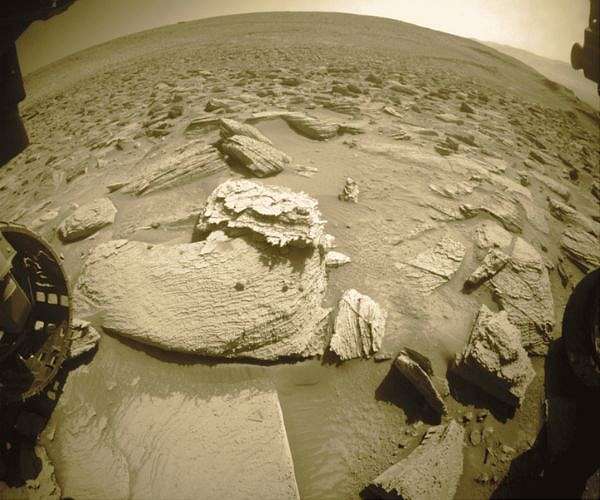23.07.2023

This image was taken by Front Hazard Avoidance Camera (Front Hazcam) onboard NASA's Mars rover Curiosity on Sol 3890.
Earth planning date: Monday, July 17, 2023. Today we planned a two sol "Touch and Go" plan. Our weekend drive successfully brought us about 28 metres, bringing us closer to the "crater cluster," a series of small craters grouped close together. These craters were created by meteoroid impacts, probably from a single meteoroid that broke up before it reached the surface.
So this mini campaign will bring us as close as possible to the cluster, for lots and lots of imaging to be analyzed, which will allow us to characterize the craters and potentially get an understanding of their origin. Hopefully we will even get close enough to get contact science on some material up here.
In today's workspace, we focused all our instruments on one target. Bedrock here (and all our recent workspaces) typically has two variations. In the accompanying image for this blog, the outcrop in the centre of the image reminds me of a lion, lying on its side, and it contains both types. The bulk of the outcrop is made up of blocks which are usually layered and often have lots of nodules - you can see this in the body of the "lion."
Then there are often minor occurrences of a more platy, brittle looking material, like this example ("Planitero") from sol 3885 - the head of the lion and its shaggy mane is made up of this material, where it has weathered into several distinct layers with ragged edges. Today we focused on this second type of outcrop. APXS will first integrate over the target "Nasia" (located on the top of the "lion's head") and then ChemCam will LIBS on the same spot. This will be followed by MAHLI and Mastcam imaging of the same target.
Mastcam will also take two small mosaics (3 images each) in the near field of the workspace - "Zarelia" will look at some nearby laminated float blocks and the "Troughs" mosaic will look at... you guessed it .... some troughs! More specifically, it will look at interactions between rock and regolith and sand in the workspace. Mastcam will also take a larger mosaic (a "15x3" mosaic, i.e., 3 rows of 15 images) focusing on the crater cluster.
The ENV theme group are busy as always. Mastcam will take a pair of tau measurements (measuring dust in the atmosphere), whilst Navcam will take a series of movies, examining martian clouds, their properties and abundances.
The cloud "zenith" movie looks directly upwards to look at clouds and their direction, whilst the "suprahorizon" movie is targeted in a more horizontal direction, looking at clouds and variations in optical depth in the atmosphere above the southern rim of the crater. DAN and REMS measurements round out the ENV plan.
Following this, our drive will take us about 30 metres, skirting along the edge of the crater cluster, and setting us for further characterization of the crater cluster on Wednesday.
Quelle: SD

